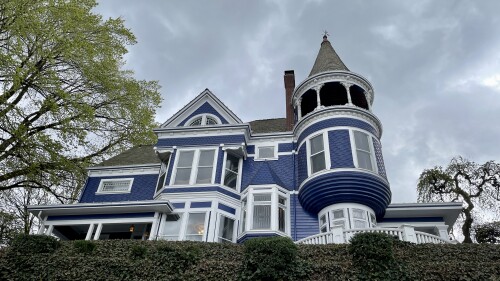Tomorrow marks the beginning of the 7th Vanport Mosaic Festival (Fri., May 20-Tues., June 7), a living memorial to a time + place that still reverberates in modern-day Portland.
Vanport’s history
At the onset of the United States’ involvement in WWII, the country’s largest public housing project was haphazardly built near the marshy banks of the Columbia River — Vanport, a portmanteau of neighboring Vancouver + Portland.
The first tenants arrived on December 12, 1942; at its peak, Vanport was the second most populous city in Oregon. Many of the ~42,000 residents worked in the shipyards or supported the war effort in other ways — up to 10,000 were African Americans.
At the time, racist practices restricted where Black people could live in Portland, and Vanport’s labor opportunities attracted more African Americans from the South. The community, which had bustling shopping centers, a 750-seat movie theater, and a sizable hospital, was diverse but still unofficially segregated — though its childcare, recreational facilities, and schools were integrated. The Vanport Extension Center opened in 1946 and would one day become Portland State University.
When the war ended, white workers left the city in droves, reducing the population to about 18,500, and on May 30, 1948, everything changed. A warm, rainy mid-May period along with rapid snowmelt in the Cascades caused the Columbia River to flood and break through a railroad embankment that served as a levee on Vanport’s western flank. In minutes, the crashing water wiped out the city, leaving at least 15 dead, countless homeless, and a racial reckoning in its wake.
Vanport’s legacy
Vanport Mosaic’s co-founder + co-director Laura Lo Forti shared insights on how Vanport’s past is still relevant 80 years later and how participants can get involved.
Q: What exactly is the Vanport Mosaic Festival?
A: Through oral history screenings, live storytelling, poetry, music and theater performances, tours, art exhibits, and dialogues, we amplify the personal experience of individuals and communities impacted by the long-endured inequalities across America’s economic, social, and civic systems.
We are so excited to be back in full gear with this year’s festival! There will be over 20 events in various locations, mainly in N/NE Portland, most of them free, and others by donation, or at a sliding scale.
Q: How did it start?
A: The festival started as a grassroots multidisciplinary 2-day event on Memorial Day weekend 2015 to elevate the history of Vanport, and to commemorate the anniversary of the flood that destroyed it on May 30th, 1948. But the seed was planted a long time before then. It started by listening to the memories of Vanport former residents and survivors.
Our effort began with a project to record their stories, and it is through their guidance that it has grown into a non-profit organization that continues to honor what they refer to as the “Spirit of Vanport.”
“Lost City, Living Memories: Vanport Through The Voices of Its Residents” is now the largest collection of first hand memories of life in Vanport, the day of the flood, and its aftermath. Our work builds on decades of story-keeping by the Vanport community and the many Portlanders who understood the importance of this story and worked to preserve it before us. Our collective effort culminated in the symbolic naming of the newest addition to Portland State’s campus.
Q: What are some of this year’s highlights?
A: One of the most exciting offerings of this year’s program is “Vanport The Musical,” written and directed by Shalanda Sims, and presented by World Stage Theatre, in collaboration with the Northwest Children Theater. Shalanda is a talented writer, director, and playwright, and her play truly brings to life the hopes and dreams of the thousands who migrate to our city to build a better life. The story is based on her own family’s history, and it centers the experience of the Black residents, celebrating the strong community they formed, and that continues to exist today.
May 28 will be a very special day. We hope many will join us at Delta Park for an afternoon of re-membering + re-seeding, co-created by artists and activists representing Black, Indigenous, Brown and communities of color with historical and emotional ties to the land where Vanport once stood. There will be ceremonies, tours, performances, pop-up exhibits, live storytelling, video installations, and some beautiful hands-on activities.
Q: What does it mean to be a memory activist?
A: If we refuse to critically examine our history, we are destined to repeat it. And when we intentionally and conveniently erase our troubling past, we also forget the lessons of strength and resilience offered by those who survived and overcame unimaginable trauma and injustice. For us, remembering is an act of resistance against historic amnesia. Memory activism is ultimately a commitment to tell a more complete, complex, and empowering story of America. History is now, and our call is for each of us to embrace our individual and collective responsibility to write a better story for the generations to come.








